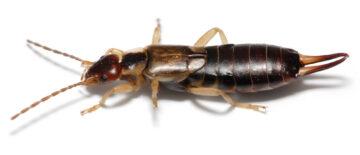A few months back we discovered a termite funnel emanating from the electrical outlet above the washer and dryer. With much trepidation we called Planet Orange, as their construction people removed the deck that surrounded the old hot tub for us late last year. They actually specialize in termite control measures; building/removing deck work is an offshoot of their normal business.
An inspector came out and went over and under every part of the house, including the crawl space that runs under almost the entire house. Now we contract with Bay Valley Pest Control to have them come out every three months to spray the exterior of the house to keep the insects there from coming in to our house–earwigs, millipedes, centipedes, ants, etc., but BV doesn’t do termite work. Of all the bugs and arachnids we have, the most pernicious are the earwigs. First pic below is a shot of one from Wikipedia.org. These guys are everywhere. Pull apart old fencing, destroy a structure, start water moving through a hose, move some rope that was damp the night before–these guys will scurry about. The worst is if I hang up a damp swimsuit one day, I have to remember to turn it inside-out and shake vigorously the next day, or there will be some waiting for me.
Then we have a bunch of other small creepy-crawlies that fall into the “not-an-earwig-not-a-spider” category, and then there’s this guy: Aphonopelma smithi, aka Bay Area Blonde Tarantula. We met this guy last summer while he was off on his death march to find a mate.
“The Bay Area Blond tarantula spider lives in an underground burrow lined with silk for most of its life, until it is about 7 years old when it reaches maturity. At this time the males leave the burrow to find mates. Males can be found on Mount Diablo in Contra Costa County, looking for mates, from September to early October. Many people go to Mount Diablo to watch the tarantulas at this time of year.”
We don’t have to travel for the festivities as these guys march right across our property. Like all tarantulas, the females live longer and do not leave their dens unless disturbed; this, plus the possibility of rattlesnake ambush, is why it’s best to move slowly and wear protection when clearing debris.
But back to the termite issue. While I waited on a quote from Planet Orange, I called around a bit and found that other businesses charge close to three hundred dollars to do an inspection, and they won’t quote based off someone else’s findings. Then there was much dithering over starting the south drainage project in conjunction with having the house treated; we had that quoted out as well but decided to not start that work at the same time (more on that whole project at a later date). It turns out we had subterranean termites, with just a few areas showing signs of drywood termites. Treating for subterranean is quite a bit easier and less expensive than dealing with a major infestation of drywood termites.
So a crew came out a few days back and got to work. First they had to sort out how to treat the area with obvious infestation signs. We thought the crawlspace extended through the bathroom and along that wall; it does not. The first image below is of one of the guys sorting out the pipe distribution and how to drill to inject the stuff without breaking any pipes or running into any electrical wires. It took the crew a good half an hour to sort out what was where and how to approach the situation, then another twenty minutes to inject the treatment “stuff,” clean up the electrical outlet where the initial funnel had formed, get rid of the debris in the wall, seal it up and repaint. Thankfully I was able to find the tin of paint left in the garage by the previous owners. A cupboard full of half-used paint tins was one of the actually useful things they left us.
Second is a shot of the area post-treatment. Once the paint had dried a bit, the washer and dryer were moved back into place.
Then it was time for drilling to begin. One of the guys submerged himself beneath the house and got to work drilling and injecting, while a second guy went about the exterior and drilled through every eighteen inches. Since there are large 4×4 concrete pavers that run along almost the entire perimeter of the house, this meant a lot of noise and dust. The holes weren’t really much to see; each one was less than a half an inch in diameter but about 18 inches deep. Once the guy was done underneath the house, they headed off for a late lunch and returned to inject and then seal up the holes with fresh concrete. The images below show the three stages.
So while not a super exciting project, it’s done and we should be less buggy in the long run.









